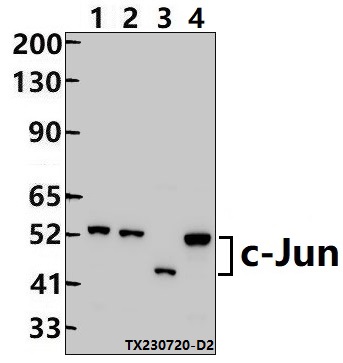Product Name :
c-Jun (Ab-91) polyclonal antibody Background :
c-Jun is a member of the Jun family containing c-Jun, JunB, and JunD, and is a component of the transcription factor activator protein-1 (AP-1). AP-1 is composed of dimers of Fos, Jun, and ATF family members and binds to and activates transcription at TRE/AP-1 elements (reviewed in 1). Extracellular signals, including growth factors, chemokines, and stress, activate AP-1-dependent transcription. The transcriptional activity of c-Jun is regulated by phosphorylation at Ser63 and Ser73 through SAPK/JNK (reviewed in 2). Knockout studies in mice have shown that c-Jun is essential for embryogenesis, and subsequent studies have demonstrated roles for c-Jun in various tissues and developmental processes, including axon regeneration, liver regeneration, and T cell development. AP-1 regulated genes exert diverse biological functions, including cell proliferation, differentiation, and apoptosis, as well as transformation, invasion and metastasis, depending on cell type and context. Other target genes regulate survival, as well as hypoxia and angiogenesis. Research studies have implicated c-Jun as a promising therapeutic target for cancer, vascular remodeling, acute inflammation, and rheumatoid arthritis. Product :
Rabbit IgG, 1mg/ml in PBS with 0.02% sodium azide, 50% glycerol, pH7.2. Storage&Stability :
Store at 4°C short term. Aliquot and store at -20°C long term. Avoid freeze-thaw cycles. Specificity :
c-Jun (Ab-91) polyclonal antibody detects endogenous levels of c-Jun protein. Immunogen :
Synthetic peptide, corresponding to Human c-Jun. Conjugate :
Unconjugated Modification :
Unmodified
c-Jun (Ab-91) polyclonal antibody Background :
c-Jun is a member of the Jun family containing c-Jun, JunB, and JunD, and is a component of the transcription factor activator protein-1 (AP-1). AP-1 is composed of dimers of Fos, Jun, and ATF family members and binds to and activates transcription at TRE/AP-1 elements (reviewed in 1). Extracellular signals, including growth factors, chemokines, and stress, activate AP-1-dependent transcription. The transcriptional activity of c-Jun is regulated by phosphorylation at Ser63 and Ser73 through SAPK/JNK (reviewed in 2). Knockout studies in mice have shown that c-Jun is essential for embryogenesis, and subsequent studies have demonstrated roles for c-Jun in various tissues and developmental processes, including axon regeneration, liver regeneration, and T cell development. AP-1 regulated genes exert diverse biological functions, including cell proliferation, differentiation, and apoptosis, as well as transformation, invasion and metastasis, depending on cell type and context. Other target genes regulate survival, as well as hypoxia and angiogenesis. Research studies have implicated c-Jun as a promising therapeutic target for cancer, vascular remodeling, acute inflammation, and rheumatoid arthritis. Product :
Rabbit IgG, 1mg/ml in PBS with 0.02% sodium azide, 50% glycerol, pH7.2. Storage&Stability :
Store at 4°C short term. Aliquot and store at -20°C long term. Avoid freeze-thaw cycles. Specificity :
c-Jun (Ab-91) polyclonal antibody detects endogenous levels of c-Jun protein. Immunogen :
Synthetic peptide, corresponding to Human c-Jun. Conjugate :
Unconjugated Modification :
Unmodified
-
 Western blot (WB) analysis of c-Jun(Ab-91) polyclonal antibody at 1:500 dilution Lane1:HepG2 whole cell lysate(30ug) Lane2:PC3 whole cell lysate(30ug) Lane3:HEK293T whole cell lysate(30ug) Lane4:A549 whole cell lysate(30ug)
Western blot (WB) analysis of c-Jun(Ab-91) polyclonal antibody at 1:500 dilution Lane1:HepG2 whole cell lysate(30ug) Lane2:PC3 whole cell lysate(30ug) Lane3:HEK293T whole cell lysate(30ug) Lane4:A549 whole cell lysate(30ug)
Endothelial cells dysfunction induced by silica nanoparticles through oxidative stress via JNK/P53 and NF-kB pathways
PMCID: Pubmed No.:20727582
VI-14, a novel flavonoid derivative, inhibits migration and invasion of human breast cancer cells
PMCID: Pubmed No.:22538171
Neurotoxic potential of iron oxide nanoparticles in the rat brain striatum and hippocampus
PMCID: Pubmed No.:22995439
ZNF16 (HZF1) promotes erythropoiesis and megakaryocytopoiesis via its regulation on c-KIT gene
PMCID: Pubmed No.:24180487
Long-term blue light exposure induces RGC-5 cell death in vitro: involvement of mitochondria-dependent apoptosis, oxidative stress, and MAPK signaling pathways
PMCID: Pubmed No.:24682673
Activation of Mesenchymal Stem Cells by Macrophages Prompts Human Gastric Cancer Growth through NF-κB Pathway
PMCID: Pubmed No.:24824968
3, 3'-Diindolylmethane attenuates cardiac H9c2 cell hypertrophy through 5'-adenosine monophosphate-activated protein kinase-α
PMCID: Pubmed No.:25816057
ZNF16 (HZF1) promotes erythropoiesis and megakaryocytopoiesis via its regulation on c-KIT gene
PMCID: Pubmed No.:24180487
Activation of Mesenchymal Stem Cells by Macrophages Prompts Human Gastric Cancer Growth through NF-κB Pathway
PMCID: Pubmed No.:24824968
Long-term blue light exposure induces RGC-5 cell death in vitro: involvement of mitochondria-dependent apoptosis, oxidative stress, and MAPK signaling pathways
PMCID: Pubmed No.:24682673
3,3'-Diindolylmethane attenuates cardiac H9c2 cell hypertrophy through 5'-adenosine monophosphate-activated protein kinase-α
PMCID: Pubmed No.:25816057
Bioworld Biotech only provide peptides for our antibodies and do not provide additional peptide customization services.
Price/Size :
USD 368/1mg/vial
Tips:
For phospho antibody, we provide phospho peptide(0.5mg) and non-phospho peptide(0.5mg).Describe :
Blocking peptides are peptides that bind specifically to the target antibody and block antibody binding. These peptide usually contains the epitope recognized by the antibody. Antibodies bound to the blocking peptide no longer bind to the epitope on the target protein. This mechanism is useful when non-specific binding is an issue, for example, in Western blotting (WB) and Immunohistochemistry (IHC). By comparing the staining from the blocked antibody versus the antibody alone, one can see which staining is specific; Specific binding will be absent from the western blot or IHC performed with the neutralized antibody.Formula:
Synthetic peptide was lyophilized with 100% acetonitrile and is supplied as a powder. Reconstitute with 0.1 ml DI water for a final concentration of 10 mg/ml.The purity is >90%,tested by HPLC and MS.
Storage:
The freeze-dried powder is more stable. For short time at 2-8°C. For long term storage store at -20°C.
Note :
This product is for research use only (RUO only). Not for use in diagnostic or therapeutic procedures.
 c-Jun (Ab-91) polyclonal antibody
c-Jun (Ab-91) polyclonal antibody  Datasheet
Datasheet COA
COA MSDS
MSDS SHIP
SHIP